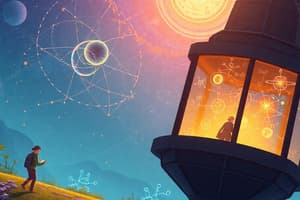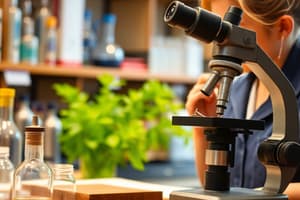Podcast
Questions and Answers
Science is best defined as what?
Science is best defined as what?
what is known about the universe and the methods used to obtain knowledge
Who determines scientific facts?
Who determines scientific facts?
anyone
Which of these is a characteristic that makes up the definition of a scientific fact?
Which of these is a characteristic that makes up the definition of a scientific fact?
use senses to make observations
How is equipment best utilized in science?
How is equipment best utilized in science?
If one sees the leaves blowing in the wind, what type of evidence is this for the existence of air?
If one sees the leaves blowing in the wind, what type of evidence is this for the existence of air?
Why might science ignore the issue of the existence of God?
Why might science ignore the issue of the existence of God?
What is the first step of the scientific method?
What is the first step of the scientific method?
Which of these would NOT be a part of the Discussion section of a scientific report?
Which of these would NOT be a part of the Discussion section of a scientific report?
What is a hypothesis stated in a negative fashion called?
What is a hypothesis stated in a negative fashion called?
To measure the amount of a substance, one would use what type of observations?
To measure the amount of a substance, one would use what type of observations?
What is the constant part of the experiment used for comparison purposes called?
What is the constant part of the experiment used for comparison purposes called?
Electrons of atoms travel in paths called what?
Electrons of atoms travel in paths called what?
In the process of ionic bonding, what happens?
In the process of ionic bonding, what happens?
What is the most abundant inorganic substance in a cell?
What is the most abundant inorganic substance in a cell?
If an atom has 12 protons in its nucleus, what is its atomic number?
If an atom has 12 protons in its nucleus, what is its atomic number?
Sodium has an atomic number of 11. How might an atom of sodium become a sodium ion (Na+)?
Sodium has an atomic number of 11. How might an atom of sodium become a sodium ion (Na+)?
Flashcards
Science
Science
The systematic study of the natural world through observation, experimentation, and the formulation of testable explanations.
Scientific Fact
Scientific Fact
An observation that has been repeatedly confirmed and is widely accepted as true.
Scientific Method
Scientific Method
A systematic approach to gaining knowledge that involves observation, hypothesis formation, experimentation, data analysis, and conclusion.
Hypothesis
Hypothesis
Signup and view all the flashcards
Control Group
Control Group
Signup and view all the flashcards
Dependent Variable
Dependent Variable
Signup and view all the flashcards
Independent Variable
Independent Variable
Signup and view all the flashcards
Atom
Atom
Signup and view all the flashcards
Atomic Number
Atomic Number
Signup and view all the flashcards
Ionic Bond
Ionic Bond
Signup and view all the flashcards
Covalent Bond
Covalent Bond
Signup and view all the flashcards
Water
Water
Signup and view all the flashcards
Carbohydrate
Carbohydrate
Signup and view all the flashcards
Lipid
Lipid
Signup and view all the flashcards
Protein
Protein
Signup and view all the flashcards
Nucleic Acid
Nucleic Acid
Signup and view all the flashcards
Cell
Cell
Signup and view all the flashcards
Cell Membrane
Cell Membrane
Signup and view all the flashcards
Cytoplasm
Cytoplasm
Signup and view all the flashcards
Nucleus
Nucleus
Signup and view all the flashcards
Ribosomes
Ribosomes
Signup and view all the flashcards
Endoplasmic Reticulum (ER)
Endoplasmic Reticulum (ER)
Signup and view all the flashcards
Golgi Apparatus
Golgi Apparatus
Signup and view all the flashcards
Mitochondria
Mitochondria
Signup and view all the flashcards
Chloroplast
Chloroplast
Signup and view all the flashcards
Diffusion
Diffusion
Signup and view all the flashcards
Osmosis
Osmosis
Signup and view all the flashcards
Active Transport
Active Transport
Signup and view all the flashcards
Enzyme
Enzyme
Signup and view all the flashcards
Substrate
Substrate
Signup and view all the flashcards
ATP
ATP
Signup and view all the flashcards
Cellular Respiration
Cellular Respiration
Signup and view all the flashcards
Glycolysis
Glycolysis
Signup and view all the flashcards
Kreb's Cycle (Citric Acid Cycle)
Kreb's Cycle (Citric Acid Cycle)
Signup and view all the flashcards
Electron Transport Chain
Electron Transport Chain
Signup and view all the flashcards
Photosynthesis
Photosynthesis
Signup and view all the flashcards
Chlorophyll
Chlorophyll
Signup and view all the flashcards
Calvin Cycle
Calvin Cycle
Signup and view all the flashcards
Light-Dependent Reactions
Light-Dependent Reactions
Signup and view all the flashcards
Study Notes
Scientific Method and Definitions
- Science investigates the universe and knowledge acquisition methods.
- Scientific facts are determined by anyone through observation.
- Scientific facts rely on sensory observations.
- Scientific equipment extends sensory capabilities.
- Observing leaves blowing is indirect evidence for air.
- Science often omits the existence of God because it's not empirically testable.
- The scientific method begins with problem identification.
- The Discussion section, in a scientific paper, does not include the dependent variable. It explains the results and draws conclusions.
- A null hypothesis is a negative statement.
- Quantitative observations measure substance amounts.
- Controls are constant aspects of experiments used for comparison.
- Atomic electrons reside in energy levels.
- Ionic bonding involves gaining or losing outer-shell electrons, not sharing them.
- Water is the most prevalent inorganic cell substance.
- An atom with 12 protons has an atomic number of 12.
- Sodium atoms become ions (Na+) by losing an outer-shell electron.
- An isotope with atomic number 6 and mass 14 has 8 neutrons.
- Water functions as a solvent, heat absorber, and lubricant, but not a direct energy source.
Organic Molecules, Cells, and Membranes
- Carbohydrates (starch, cellulose, glycogen) are a group of organic molecules.
- Lipids are a highly concentrated energy source.
- Proteins are biological catalysts.
- Nucleic Acids carry genetic information.
- Carbohydrates provide a readily available energy source for life.
- Electrons have a negative charge.
- Water exhibits polarity, heat resistance, and hydrogen bonding.
- Denatured proteins/DNA lose their shape and function due to hydrogen bond disruption.
- Hydrolysis is a breakdown reaction.
- Carbon atoms can bond with a maximum of four other atoms.
- Proteins' monomers are amino acids.
- Carbohydrates' monomers are saccharides.
- Cell membranes chiefly consist of a phospholipid bilayer and proteins.
- Cell theory states organisms are composed of cells arising from pre-existing cells, with cells as life's fundamental units.
- Organelles compartmentalize cellular functions, are membrane-enclosed, and are typically in eukaryotic cells.
- Protists, plants, and fungi generally have cell walls, unlike animals.
- The cell wall may lie outside a plasma membrane.
- Plasma membranes are composed of proteins embedded in a phospholipid bilayer. The lipid bilayer is fluid and flexible, not rigid and inflexible.
- Phospholipid molecules have a nonpolar fatty acid tail and a polar head.
- Transmembrane proteins facilitate large molecule transport.
- Glycolipids, carbohydrate attachments, contribute to cell recognition.
- Plasma membrane proteins perform functions like transport, cell-cell recognition, attachment, and receptor sites.
- Phagocytosis is "cell-eating."
- Active transport needs energy for substance movement across membranes.
- The Na-K pump exemplifies active transport.
- Pinocytosis is a nonspecific endocytosis that encompasses phagocytosis.
- Endocytosis and exocytosis involve bulk passage across the cell's membrane.
- Facilitated diffusion utilizes a protein carrier for high-to-low concentration transport without energy.
Enzymes and Metabolism
- Enzymes function as biological catalysts, reducing activation energy for reactions.
- An enzyme's substrate-binding region is the active site.
- Oxidation involves electron loss.
- Anaerobic processes do not require oxygen.
- Vitamins act as coenzymes.
- Enzymes are proteins, not inorganic compounds.
- The sun is Earth's primary energy source.
- The transition state in an enzyme-catalyzed reaction possesses high energy because of altered reactant structure.
- The first law of thermodynamics states that energy cannot be created or destroyed.
- The Krebs cycle is a cyclic metabolic pathway.
- ATP's phosphate transfers are a rapid, renewable, and common energy delivery method.
- Enzymes are affected by pH and temperature.
- Electron transport systems involve transfer processes across membranes.
- ATP stores and transports energy for the body.
- Acetyl CoA is a key intermediate in carbohydrate, protein, and fat metabolism.
- Fermentation byproducts are alcohol, carbon dioxide, and lactic acid, not acetyl CoA.
- Glycolysis occurs in the cytoplasm.
- Eukaryotic oxidative respiration takes place within the mitochondria.
- Electron carriers, like NAD and FADH, are not ATP.
- The complete oxidation of glucose proceeds through glycolysis, pyruvate oxidation, the TCA cycle, and the ETS.
- The final electron acceptor in respiration is oxygen.
- Pyruvate is glycolysis's end product.
- Aerobic glucose oxidation yields 36 ATP molecules.
- The ETS occurs within the mitochondrial inner membrane.
- One Krebs cycle yields 6 NADH molecules from NAD+ reduction.
- Fermentation products are ethanol or lactic acid, not other compounds.
- Glycolysis begins and ends in the cytoplasm.
- Aerobic respiration's later stages occur in the mitochondrion.
- Oxygen is the final electron acceptor in complete aerobic respiration.
- The TCA cycle does not include PGAL.
- FADH2 is not a glycolysis product.
- Glycerol, fatty acids, and amino acids are potential energy sources aside from glucose.
- Glycolysis alone produces 6 ATPs.
- Fermentation regenerates NAD+.
- Covalent bonds are broken in glucose during respiration.
Photosynthesis
- Chlorophyll, an essential pigment in plants, absorbs red light.
- Photosystem II obtains electrons needed for chlorophyll replacement through water molecules.
- Carbon fixation is catalyzed by RuBP carboxylase (RuBisCO)..
- Light-dependent reactions (photosynthesis) do not include carbon fixation.
- The electron flow in light reactions is: water, photosystem II, photosystem I. then NADPH.
- Water provides the oxygen released in photosynthesis.
- The Calvin-Benson cycle begins when carbon dioxide joins RuBP.
- Light absorption by a photosystem triggers light-dependent reactions in plants.
Studying That Suits You
Use AI to generate personalized quizzes and flashcards to suit your learning preferences.




